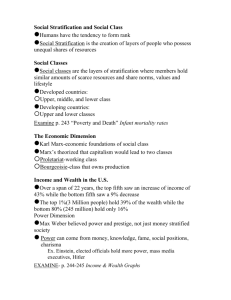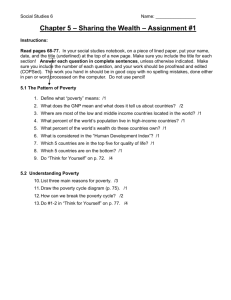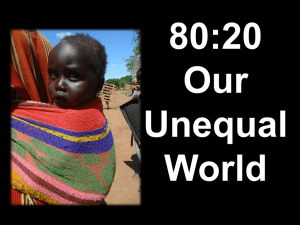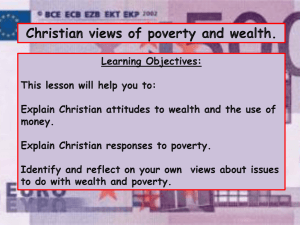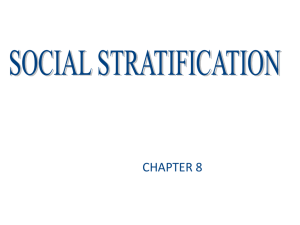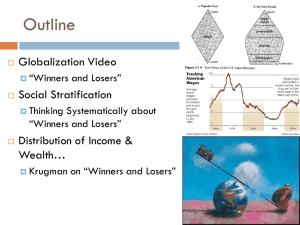Essentials of Sociology Fourth Edition
advertisement
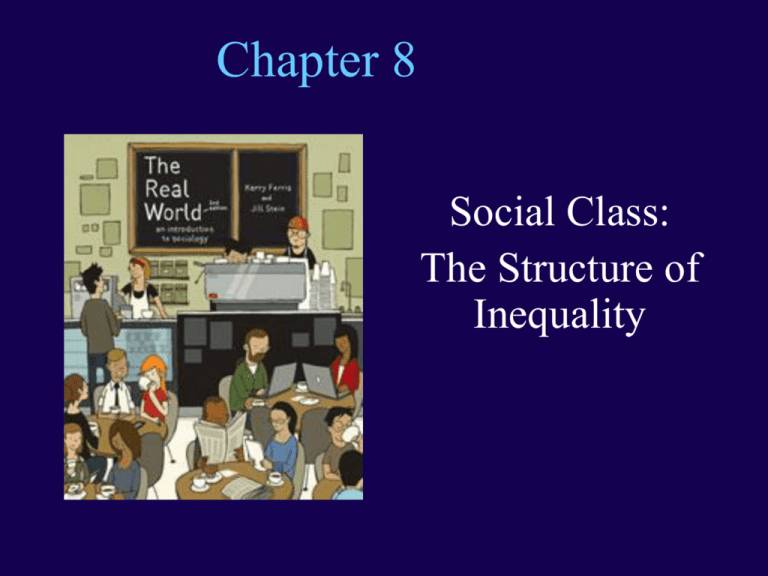
Chapter 8 Social Class: The Structure of Inequality Overview • Social Stratification Components of Social Class • Theories of Social Class Video Presentation: “People Like Us” • SES and Life Chances • Social Mobility “The American Dream” • Poverty and the Poor 2 SOCIAL STRATIFICATION Macro-level analysis • Society is grouped into strata Hierarchy, levels, layers • A system for ranking and dividing large groups of people Every society stratifies members Almost every aspect of life is linked to position in social hierarchy Persistent over generations • Results in social inequality Unequal division and sharing of social resources/rewards • Systems of stratification Slavery, caste, social class • Stratification in the U.S. Social class; race and ethnicity; sex and gender 3 SOCIAL CLASS • Defining Social Class Based on access to social resources/rewards A large group who rank closely to one another in: • wealth, power, prestige Socioeconomic Status (SES) • A measure of one’s place within class system 4 Components of Social Class: WEALTH • Wealth consists of property and income Wealth and income are not the same Some have wealth but little income • “Old” and “New” Money • Unequal distribution of wealth in the U.S. Top 1% owns 35% Top 20% owns 50% Bottom 80% owns 15% Components of Social Class: • POWER The ability to carry out one’s will despite resistance The “Power Elite” • C. Wright Mills • Those who make the big decisions in U.S. society Power is concentrated in the hands of the few • PRESTIGE Social honor • Membership in wellregarded group Occupational prestige • How a person is perceived by others • Can affect wealth and power 6 7 Components of Social Class: STATUS • Social ranking Similar in wealth, power, prestige: • Status consistency A mix of high and low rankings: • Status inconsistency Theories of Social Class: Postmodernism • Social Reproduction Pierre Bourdieu • Classes remain relatively stable Status passed down through generations • Each generation acquires cultural capital Tastes, habits, expectations, skills, etc. Can help or hinder us from gaining advantages 10 Theories of Social Class: Symbolic Interactionism • Class Consciousness (Awareness) • Erving Goffman • How we use status “cues” to categorize ourselves and others Speech, gestures, clothing, possessions, friends, activities, etc. 11 Video Presentation 12 Socioeconomic Status and Life Chances Inequality shapes life course • Privileges, hardships, differences Family • Homogamy, age of marriage, child rearing Education • Access, attitudes and expectations; attainment and status Work • White- vs. blue-collar occupations, income gap, un- and underemployment Criminal Justice • Who gets caught, prosecuted and sentenced; victimhood Health • Feeling good, health practices, life expectancy 13 SOCIAL MOBILITY • Movement of individuals or groups within class hierarchy U.S. has “open” system • Change is possible • What are your chances? Vertical (upward and downward) Horizontal • Types: Intergenerational mobility • Movement from one generation to the next Intragenerational mobility • Movement during one’s own lifetime Structural mobility • Movement of large groups of people 14 Wealth Quiz Country A Country B Country C Which nations do the charts above represent? 1. The United States, Spain and Egypt 2. Freedonia, Sweden and the United States 3. Luxembourg, the United States and Somalia 15 Wealth Quiz Country A Country B Country C Which place would you like to live in? 1. Country A 2. Country B 3. Country C 16 Video Clip “Land of the Free, Home of the Poor” 17 The “American Dream” The belief that: 1. 2. 3. 4. Everyone can participate equally and can always start over It is reasonable to anticipate success Success is a result of individual characteristics and actions under one’s control Success is associated with virtue and merit The American Dream • Ideology A belief system that legitimizes stratification • Everyone has equal chance • Success or failure depends on individual The U.S. meritocracy • Rewards are based on merit Upward mobility may be limited • Factors such as nationality, race and gender • Recession Shrinking middle class • In-Class Exercise • Questioning the Dream The “good life” and consumption • Americans are less secure and satisfied – More in debt • Less free time and more rushed The Simplicity Movement • Alternative, non-materialist values • Encourages downsizing POVERTY AND THE POOR • Definitions: Relative deprivation • Inability to maintain customary standard of living Absolute deprivation • Inability to meet minimal standards Poverty line (2010) • Based on household budget – $22,314 family of 4; $11,139 individual • Poverty in U.S.—2010 46.2 million people or 15.1% of the population or 1 in every 6.5 citizens 21 Who are the Poor? • They are a very diverse group Clustered by: • Race and Ethnicity • Age • Gender • Educational Level • Geographic Region • Country of Origin 23 The Working Poor • Minimum Wage Federal: $7.25 California: $8.00 • Many adults below poverty line work for a living Often low-paying, seasonal, temp, or part-time jobs 25 Social Welfare Programs • The “New Deal” and social safety nets FDR 1933-1937 • Social insurance programs: Social Security, disability, minimum wage • The “Great Society” and the war on poverty LBJ 1963-1969 • Public assistance programs: Medicare and Medicaid, food stamps, Head Start • Welfare Reform Clinton 1996-2000 • “Welfare to work”, limit of 5 years • The “New New Deal” Obama 2009- 27 Poverty in the U.S. • “The Culture of Poverty” Focus on attitudes among poor • Resignation and fatalism – Rather than trying to improve circumstances • Poverty is self-perpetuating Critics call this “blaming the victim” • Must see structural conditions that lead to poverty • The “Just-World Hypothesis” The deep need to see the world as orderly, predictable and fair • Tendency to view victims of injustice as deserving of their fate • Invisibility of Poverty Large part of U.S. population remains hidden • Few images of poverty in America • Residential Segregation Separation or isolation of poor from rest of the population • Often occurs along racial lines • Political Disenfranchisement Removal of rights through economic or political means • Poor participate in politics less • Lack power and visibility of their issues 28 Global Poverty • Global Rich List (globalrichlist.com) The 225 richest people in the world have a combined wealth of $1,000,000,000,000 (trillion) Equal to the combined income of the world’s 2.5 billion poorest people • Wonder what it would be like to have that kind of money? Where would you be on a list of the richest people in the world? • If you have an annual income of $50,000 You are in the top 0.98% richest people in the world You are the 59,029,289 richest person in the world • How do you feel about being so rich? The lives of many of the poorest in the world could be improved dramatically if you donated just one hour's salary (approx $26.70) • The One Campaign (one.org) Campaign to make poverty history Increase federal budget aid to world poverty one percent 29 Next … 30
